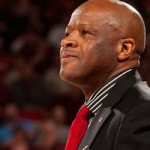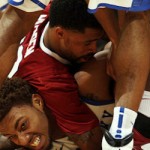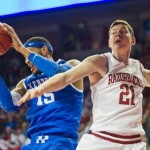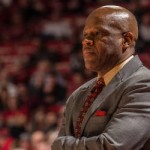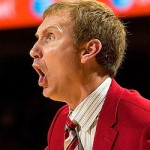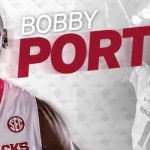B.J Young, meet Olu Famutimi.
Seems we’ve heard this one before: Highly acclaimed prep star has NBA visions firmly planted in his head before even arriving at his college, decides after one year that maybe he wasn’t a one-and-done after all, and then bolts college ball after two seasons — still not ready for the show.
The 6-foot-5 swingman Famutimi, one of Stan Heath’s better signees — and, at least to this point, we can say Stan Heath remains the best recruiter Arkansas has had in the head coaching role in the past 16 years — next showed up in Arkansas playing in the NBA’s Developmental League. He arrived at Arkansas coming off a serious knee injury and never regained the form that had made him a McDonald’s All-American.
However, for a time his biggest backers insisted Famutimi could be the first Canadian to go No. 1 in the NBA Draft. (A Canadian finally went first on Thursday night, when UNLV power forward Anthony Bennett was selected No. 1 by the Cleveland Cavaliers.)
B.J. Young, a 6-2 guard out of St. Louis, has never carried as much acclaim as Famutimi did in the prep ranks, but he was considered a Top 20 recruit three years ago as part of John Pelphrey’s last signing class, the one Pel ultimately didn’t get to coach and one that now is down to just one player left in Fayetteville after an original class of five (Young, Hunter Mickelson, Devonta Abron, Aaron Ross, and the last of the Mohicans, Rashad “Ky” Madden).
Most of the big programs, for whatever reason, were turned off of Young during his high school and AAU career — Florida, for example, zeroed in on fellow St. Louis guard Bradley Beal but stayed clear of Young; Mike Anderson, then coaching Missouri, reportedly didn’t recruit Young as well.
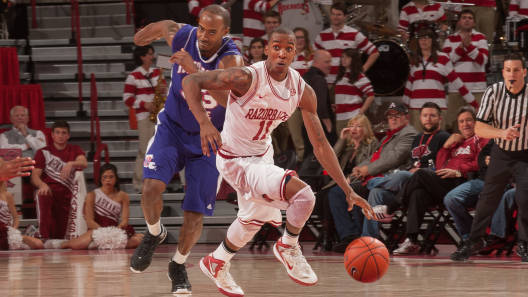
Former Razorback B.J. Young
But Anderson inherited Young as part of that final Pelphrey signing class, and he gladly took what Pelphrey had left, even if various players have proven to be less than a fit for Anderson’s style of basketball.
B.J. Young thrilled the fans with occasional last-second heroics and frustrated them equally with crazy, impossible decisions. Point in case: this past season’s Auburn game at Bud Walton Arena, when Young on three occasions took it upon himself to win the game — he was stuffed in the lane on a wild drive at the end of regulation; denied again at the close of the first overtime; then, despite all the previous rejection, made the Hogs a winner with a rare 3-point bomb over one of the worst teams in the SEC.
Young’s brief career line at Arkansas doesn’t trend upward. In overall shooting, it nosedived. He was at least competent as a 3-point shooting freshman, but then displayed a new yet ineffective shooting form that was painful for the purists to watch last season. Somewhere along the way from withdrawing from the 2012 NBA Draft, Young had been convinced to alter his shooting style to something more sound, but the newer teaching didn’t take.
Razorback fans will look at Thursday’s two rounds of an NBA draft, where both B.J. Young and junior power forward Marshawn Powell were not selected, and insist that each should have returned for another season. That would be assuming, at least in Young’s case, that Anderson still left a spot for him to keep.
There’s no question Young and Anderson fought over what Young wanted to do compared with what Anderson expected from his guard. At his best, when Young was committed to team play and displayed some uncanny passing instincts, Arkansas was decent offensively, even on the road where the Hogs still won just once. And surely there were times Anderson had to be happy he had at least one player with the daring to try to win a game at the end; too many players don’t want the ball in their hands at crunch time.
But those other times, such as when Young purposely wouldn’t rotate the ball to guard Kikko Haydar or look inside for a pass to a high percentage shot, but rather would play one-on-one basketball to boost his own stock, Anderson was obviously left cringing while squirming in his seat.
On paper, Young has terrific full-court speed and surely has the potential to restore his outside shot with the right off-season tutoring. No doubt he’s not afraid to mix it up inside, either, though some common sense on that front needs to take hold.
Somebody will take a chance on Young to at least work him through the Developmental League. Or, he could devote himself fulltime to overseas leagues to further develop his game and come back five years later contributing the way another former Heath recruit, Patrick Beverley, did for the Houston Rockets this past season.
There’s some thought, though Hog fans don’t want to hear it, that under Anderson and his staff, Young wouldn’t have improved had he stayed. He had to want to listen, first of all. And fact is, in two years he went backward in most every phase except his overall strength and muscle — remember, as game as he was coming in, he was knocked around unmercifully against power teams such as Florida during his freshman year.
On the other hand, Anderson and his staff deserve kudos from bringing along Marshawn Powell over the past two years. Powell usually was no longer the moody personality on the court and accepted a leadership role. He developed a decent outside shot to add dimension to his game, which would be hampered in the pro ranks if it were all inside, with his 6-7 (at best) height, limited lateral quickness and lack of lift.
Powell had spent four years in Fayetteville and it was time to move on. He’ll have some suitors overseas to make some money.
Archie Goodwin, the Sylvan Hills product who kept his promise of playing just one year of college ball at Kentucky, went 29th to Phoenix. The 6-5 swingman had been projected anywhere from the middle of the first round to the 30th choice. The draft as a whole was disappointing with no huge impact players or true difference-makers and mostly role-type players among the early choices.
With all that mediocrity, the odds still were good that Young would not be drafted Thursday. Surprising, though, is that a former Mike Anderson pupil, 5-foot-10 Missouri point guard Phil Pressey — who passed up his senior year — went undrafted. While his shooting is suspect, Pressey is a true backcourt quarterback who can help an NBA offense. We’ll see him eventually in the league.
Young could be that same kind of setup artist, but that wasn’t his first priority. At 6-foot-2, it will have to become his focus if he wants to realize his hoop dreams.



